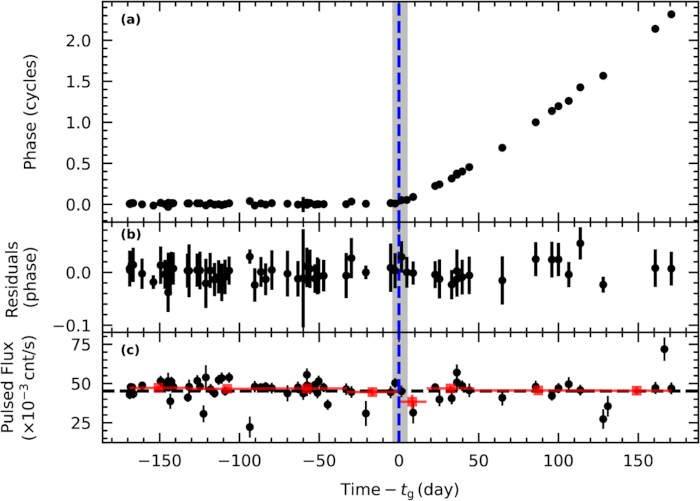NICER / ISS Science Nugget
for May 2, 2024
A surprising slow-down
More than half a century after their discovery, neutron stars still surprise us. The extraordinary weirdness of the states of matter within them, coupled with their unique magnetic properties, drive dynamic and unpredictable behaviors. Among the most fascinating of these, offering up clues to the stars' interior structure, are spin "glitches," sudden changes in the rotation of a pulsar revealed by timing the arrival of its pulses at our telescopes. Spin glitches are commonly seen in young pulsars, where emissions are powered by rotational kinetic energy, but also in magnetars (thought to be energized by decaying ultra-strong magnetic fields). Historically, rotation-powered pulsars (RPPs) have only exhibited spin-up glitches -- i.e., increases in their rotation rates -- while a few magnetars have experienced glitches of both signs.
The mechanisms underlying these events require transfers of angular momentum between the star's core and its crust. For the more-common spin-up glitches, a neutron superfluid in the core is believed to govern the star's bulk rotation, while the crust experiences drag from having to sweep around the strong magnetic field, which is pinned to a layer of superconducting protons. When tension between these two components becomes too great, the structure yields and the crust is spun up to the core's rate. The mechanism for spin-down glitches in magnetars remains largely mysterious, but magnetic-field reconfigurations are suspected because the spin events are usually accompanied by changes in X-ray brightness, spectrum, or both.
In a paper accepted this week for peer reviewed publication in The Astrophysical Journal, a team led by Y. Tuo (Eberhard Karls Univ., Germany) report the first-ever detection of a spin-down glitch in a rotation-powered pulsar. PSR B0540-69, a young neutron star that resides in the Large Magellanic Cloud, spins at a rate of 20 revolutions per second, with a history of unusual spin behavior that originally motivated NICER's long-term monitoring. The surprising evidence for a sudden slowing down of an RPP - by a tiny but distinctly measurable amount, a fractional change of 5 billionths of the spin frequency - with no accompanying change in brightness suggests an internal cause. The authors speculate in the case of B0540 that a small amount of the neutron superfluid transitioned to a "normal" non-superfluid state, increasing the moment of inertia and slowing down the core, a change that was eventually transmitted to the crust.
Continued study of the long-term spin behavior of B0540 offers a unique opportunity to probe exotic physical conditions in which quantum fluids - superfluid neutrons and superconducting protons - can coexist on a scale that is conveniently measured in units of the mass of our Sun.

NICER timing and brightness measurements of the rotation-powered pulsar B0540-69, centered approximately on July 7, 2023 (dashed vertical line with gray-shaded uncertainty), the date of an apparent spin-down glitch. Panel (a) shows observed minus expected pulse arrival times. Increasingly delayed pulses to the right of center indicate slower rotation. Panel (b): Timing "residuals" consistent with zero suggest the spin-down glitch model is a good fit to the data above. Panel (c): Pulsed brightness around the glitch in the 0.5-12 keV photon energy band, for individual NICER observations (black) and averaged data (red points and horizontal range bars). (Figure credit: Tuo et al. 2024)
<< Previous
Main Index